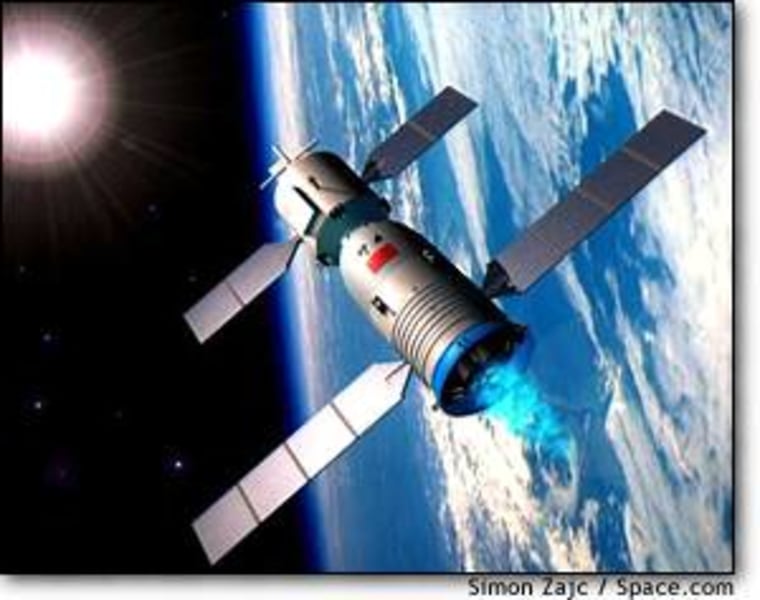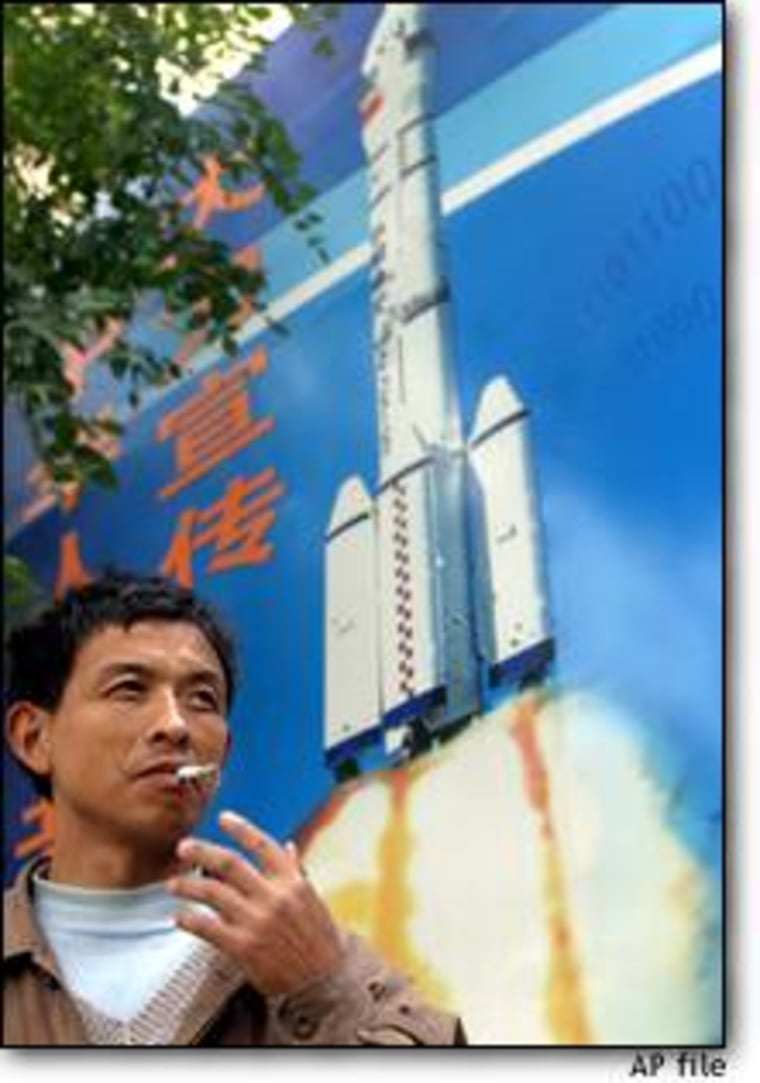OK, let’s assume that Shenzhou 5 makes its orbital flight with its human cargo and returns safely to Earth. China exults. Space buffs around the world congratulate. Western experts pontificate. Now what?
Just carrying a Chinese citizen into space for parades in Beijing is only the start. That trick would wear out pretty quickly.
If that were all that was needed, Shenzhou is much too complicated. China actually began development of a very limited one-person manned space capsule 20 years ago, and even began training astronauts. But when it became clear that the expensive vehicle wouldn’t be able to carry out any really useful missions in space, it was canceled.
The Shenzhou spacecraft and its support systems are obviously designed for more than that, and to carry out specific complex missions. It’s clear that future missions will carry three crewmen, fly for extended periods, support testing of spacewalks and orbital dockings, carry specialized science and technological equipment, and move toward deployment of a Chinese space station similar to Russia’s venerable Mir (1986-2001).
We suspect this, because Chinese officials in more serious moments and properly translated interviews have said as much. But we can also believe it, because they have built the Shenzhou hardware with features that make sense only when used for exactly those missions.
For example, look at the solar panels mounted on the craft’s service module and on its orbital module. They provide three times the power used on the Russian Soyuz, which acts merely as a ferryboat from Earth to a space station and back. Shenzhou’s orbital missions will be more sophisticated than that.

Moreover, Shenzhou’s solar arrays, unlike those on Soyuz, can rotate to track the sun while the spacecraft itself is aligned for other purposes, such as Earth observation or long-term microgravity drifting flight. The Russians did put rotating solar panels on another of their manned spacecraft, their Salyut-class space stations, and for exactly this same reason.
And Chinese engineers have mounted a pair of solar panels on the orbital module, which in the Russian Soyuz variant has none, because it is discarded after the crew returns to Earth. Instead, on Shenzhou missions the orbital module remains behind in orbit as a mini-space station with long-term experiments of its own.
Earlier this year, Chinese space official Zhang Qinqwei told People’s Daily that these modules remain in space “to lay a foundation for China’s second-step manned spaceflight project — forming a docking link between a spacecraft and another flight vehicle.”
InsertArt(2040199)To do this, the hatch between the orbital module and the descent module must be closed with a special-shaped conical target so that a docking probe on the nose of the next Shenzhou can capture it. The orbital module from the new Shenzhou would then be permanently attached to the one that had been left in space on the previous mission. When we see this in photographs, we’ll know what it means.
This process could continue mission by mission, with several of the modules linked sausage-style to create a small lab with impressive electrical power capabilities. A magazine article in 2002 described such a facility: “After it succeeds in manned spaceflight, China will very soon launch a cosmic experimental capsule capable of catering to astronauts’ short stays.”
Future space station options
The next step, after several years of working with this approach, will be a fully-outfitted Mir-class station weighing 15 to 20 tons. A photograph of such a spacecraft mockup has been released.
Once that is available, China will need improved Shenzhou vehicles capable of staying in space six months or more. The most visible features of the long-duration habitable vehicle, such as Soyuz, are deployable covers over windows and rocket nozzles to protect them from temperature extremes and space junk impacts. The current Shenzhou vehicle does not have such features. When they appear in pre-flight photographs, they will confirm that long-term space missions are near.
Since the Shenzhou will use a docking mechanism based on the Russian design also used for Soyuz and Progress visits to the international space station, the obvious question is whether China too can dock to the space station. They can, but it seems they don’t really plan to.
The orbital path chosen for Shenzhou flights is inclined 42 degrees to Earth’s equator, while the space station orbits at an inclination of 52 degrees. Vehicles in one orbit cannot change course to match vehicles in the other orbit.
True, China could launch a Shenzhou along a different path, and enter a 52-degree orbit directly. But the lack of any immediate interest in doing so was conveyed by the construction of a special tracking site in Namibia, in southwestern Africa, for monitoring the spacecraft descent back to Earth.
For a 42-degree inclination orbit, a spacecraft heading for the regular Inner Mongolian touchdown point passes directly over the African tracking site. But a spacecraft returning from an orbit compatible with the space station at 52 degrees would pass too far south of the tracking site for any useful communications. True, a tracking ship could be deployed in the appropriate region, at great expense. When (and only when) such a ship appears, a Chinese visit to the space station will be indicated.
During the next several years, we can also expect to see some testing of spacesuits for spacewalks. A hatch in the side of the Shenzhou’s orbital module can be used to leave the spacecraft while it’s in orbit. But early spacewalk activity in the U.S. and Soviet programs was driven by the need for testing systems for walking on the moon, which is not a Chinese priority. Repair and assembly work on the long-term station will also require spacewalks, so expect the Chinese to carry out practice walks as the launch of that vehicle nears.
Picking up the pace
China has launched five Shenzhou vehicles in a period of four years, which is not an impressive launch rate. But each one was meticulously handcrafted with improvements based on previous flight experience. Now that the design has been validated and standardized, the same level of expenditure will probably be able to manufacture and launch at least twice as many vehicles in the same time period.
That means we should be able to expect two to four Chinese manned flights per year over the next five years, with mission durations of up to several weeks. Some flights will test new technologies and new flight techniques. Others will assemble and use the “space train” of linked orbital modules. Depending on international negotiations, one or more may visit the space station as a symbolic demonstration. China may take representatives of its own space partners — perhaps a Brazilian, perhaps a Pakistani, perhaps even a European — into orbit.
With larger boosters coming on line in five or 10 years, and with the confidence that comes with experience, the Shenzhou may be modified even further. We’ll see the addition of high-gain radio antennas, installation of a thicker heat shield, and other modifications that will confirm China’s intent to fly beyond low Earth orbit. Words of officials can be merely wishes, but when the hardware speaks, it tells truth.
James Oberg, space analyst for NBC News, spent 22 years at the Johnson Space Center as a Mission Control operator and an orbital designer.
